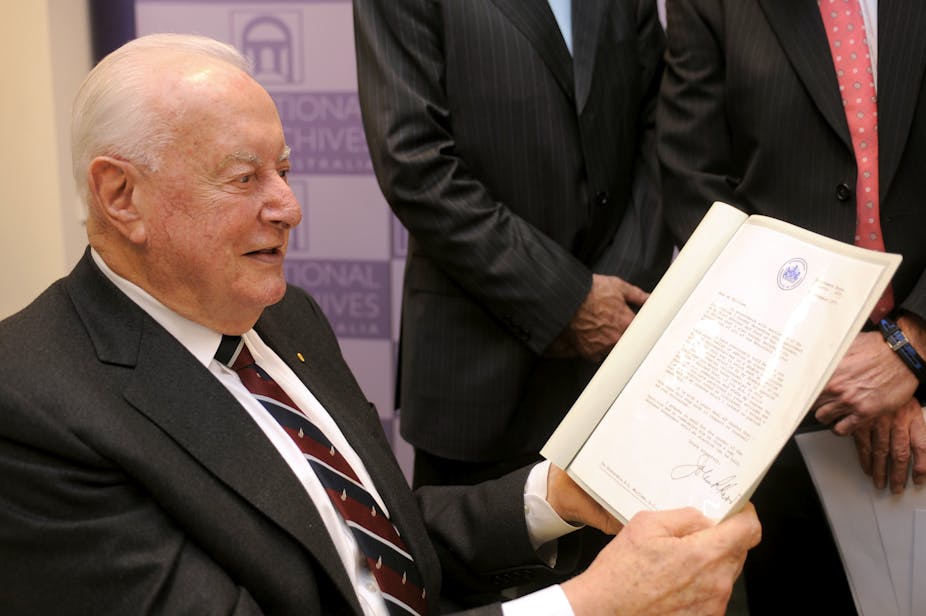Recently disclosed archival documents in both Australia and the UK have revealed more about the role of the royal family and the UK government in Gough Whitlam’s dismissal in 1975.
A new book claims that the governor-general, Sir John Kerr, may have informed the royal family of his decision as early as August of that year. But, the UK government tried hard to keep itself and the Queen out of it.
The book, The Dismissal Dossier by Monash University’s Jenny Hocking, says that Kerr had discussed “contingency” plans with Prince Charles and the Queen’s private secretary, Sir Martin Charteris, in the months before the dismissal.
This statement, also made in the second volume of Hocking’s Whitlam biography, refers to Kerr’s recollections in his private journal – written in 1980 – of the crisis. Kerr’s journal mentions discussing the possible dismissal of the government with Prince Charles and Charteris. All acknowledged that the Queen, if she were to be involved, “would have to take the prime minister’s advice”.
The royal family is refusing to release any correspondence between them and Kerr, citing the 50-year embargo on the monarchy’s private papers.
While Kerr was maintaining secret correspondence with the royal family and their staff, the Foreign and Commonwealth Office in London and the British High Commission in Canberra were also trying to work out what role – if any – the Queen might play in the affair. The correspondence between the two reveals that they were at pains to keep the Queen and the Wilson government out of the crisis.
From late September 1975, the High Commission warned London that an early election might be called, based on the proposal by the opposition leader, Malcolm Fraser, to block supply in the Senate. From mid-October, the Foreign and Commonwealth Office was becoming increasingly worried that the Queen would be called on to intervene. There was then a multitude of letters sent trying to forestall this.
However, the Foreign and Commonwealth Office’s presumption was not that Kerr had indicated his intentions to the Queen. The British opinion was that Kerr was “already well qualified” to make any decision himself. The worry was that Whitlam, in a hope to break the deadlock, would request the Queen order the state governors to issue writs for a half-Senate election, thus possibly robbing Fraser of his hold on the Senate.
But the High Commission warned that this was only one (yet far-fetched) option open to Whitlam. On October 24, it suggested:
Alternatively, if [Whitlam] seemed determined to stick it out it is not inconceivable that the Governor-General himself might decide that the situation had become sufficiently serious for his intervention.
The UK foreign secretary, James Callaghan, was advised that “any move by the Australian government to involve the Queen seems very improbable” and that Whitlam, although the option was possibly open to him, was unlikely pursue it.
To pre-empt any request for intervention by the UK government or Buckingham Palace, the Foreign and Commonwealth Office briefly flagged the idea of having Charteris:
… be advised to get in touch with Sir John Kerr with a view to “blocking off” any attempt to involve the Queen in Australian domestic politics.
But this was ruled out. It was felt that “such advice could well offend the Governor-General” and if Whitlam had got wind of this he “would inevitably suspect the UK’s involvement”. The final recommendation reached was:
We should do nothing for the time being, except to continue to watch developments carefully. Should he ask, we could tell Sir Martin Charteris that we have given careful consideration to the manner but that inaction seems the best policy.
When the dismissal did occur on November 11, both the High Commission and London were taken by surprise. As anger in Australia was directed towards the governor-general – the Queen’s representative in Australia – the British tried to avoid being blamed. A telegram sent on November 13 from London clearly said:
It has accordingly been decided that UK ministers should avoid any involvement in this exclusively Australian domestic political dispute.
It was proposed that the line to take by the High Commission would be:
There is no ministerial or parliamentary responsibility at Westminster. It would be highly improper for any of us to enter into these very difficult problems – constitutional and others – which have arisen in Australia.
Hocking’s book shows that Kerr probably made his own decision about Whitlam much earlier than he acknowledged publicly while alive – but that he came to this conclusion in discussion with others, including Prince Charles and Charteris.
The archives reveal that both London and Canberra were unaware of this. They also show that the British were keenly following events leading up to the dismissal, while hoping that these events would not engulf them and require intervention.
Until the last days of the crisis, the High Commission fully expected Whitlam to weather the controversy. It also severely underestimated the tenacity of Fraser to unsettle the government, thus provoking the crisis that needed Kerr to intervene in the way that he eventually did.
Hocking has done superb work on uncovering the links between Kerr and the royal family, although we are still waiting on the release of further papers. Until this happens, we cannot know the full story.

